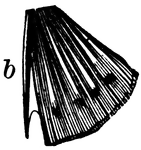Clipart tagged: ‘Bony fish’

Anglerfish
Anglerfish are the members of the order Lophiiformes. They are bony fish named for their characteristic…

Menhaden
A fish found in abundance off the Atlantic coast of North America, and often called whitefish, hardhead,…

Seahorse
Seahorses are a genus (Hippocampus) of fish belonging to the family Syngnathidae, which also includes…

One Spine on the Ventral Fin of a Bony Fish
"A fin-spine; one of the unjointed and unbranched sharp bony rays of the fins, such as those the presence…

Ten Spines on the Fins of a Bony Fish
"A fin-spine; one of the unjointed and unbranched sharp bony rays of the fins, such as those the presence…

Three Spines on the Anal Fin of a Bony Fish
"A fin-spine; one of the unjointed and unbranched sharp bony rays of the fins, such as those the presence…

Sturgeon
Sturgeon is the common name used for some 26 species of fish in the family Acipenseridae, including…
